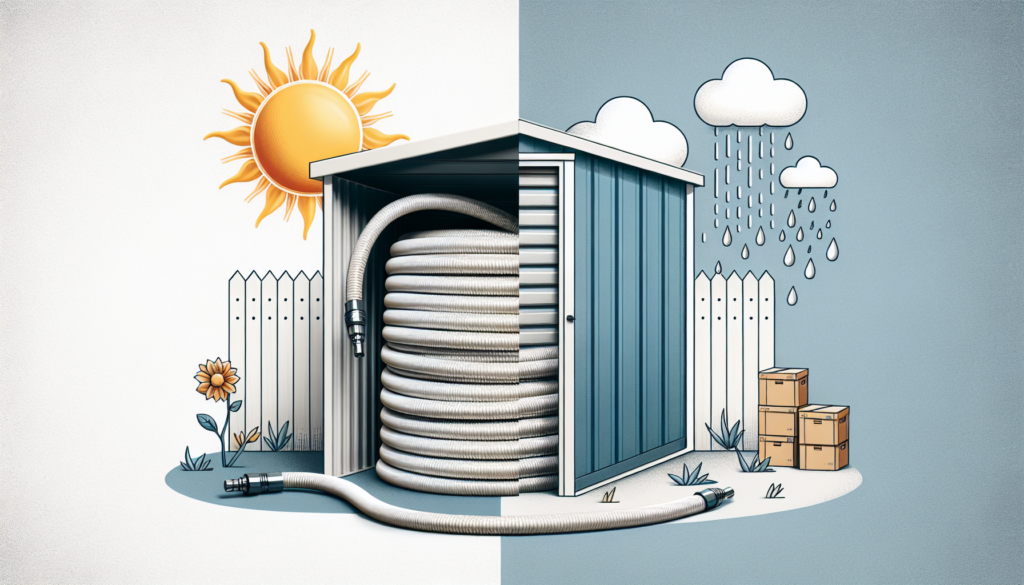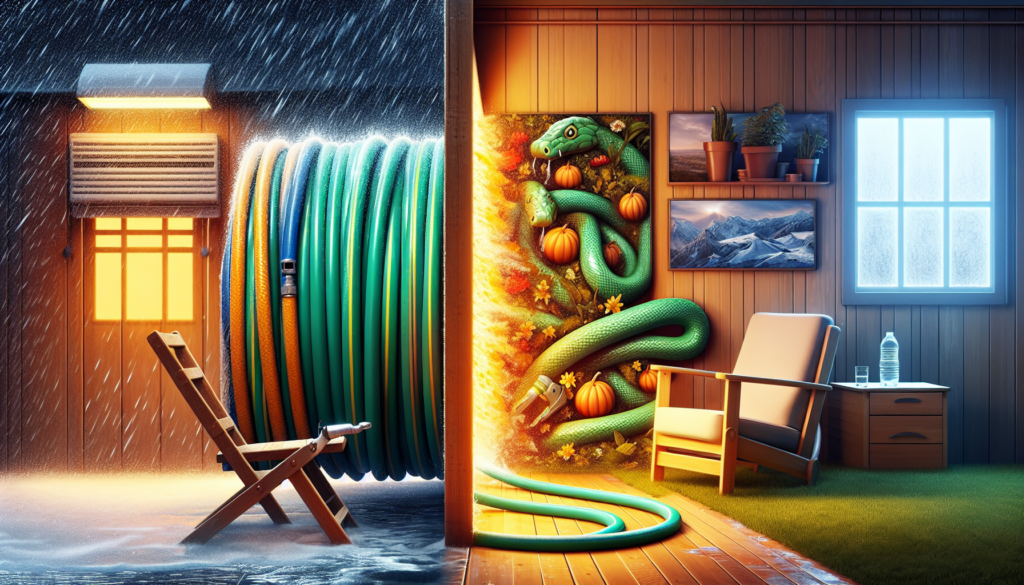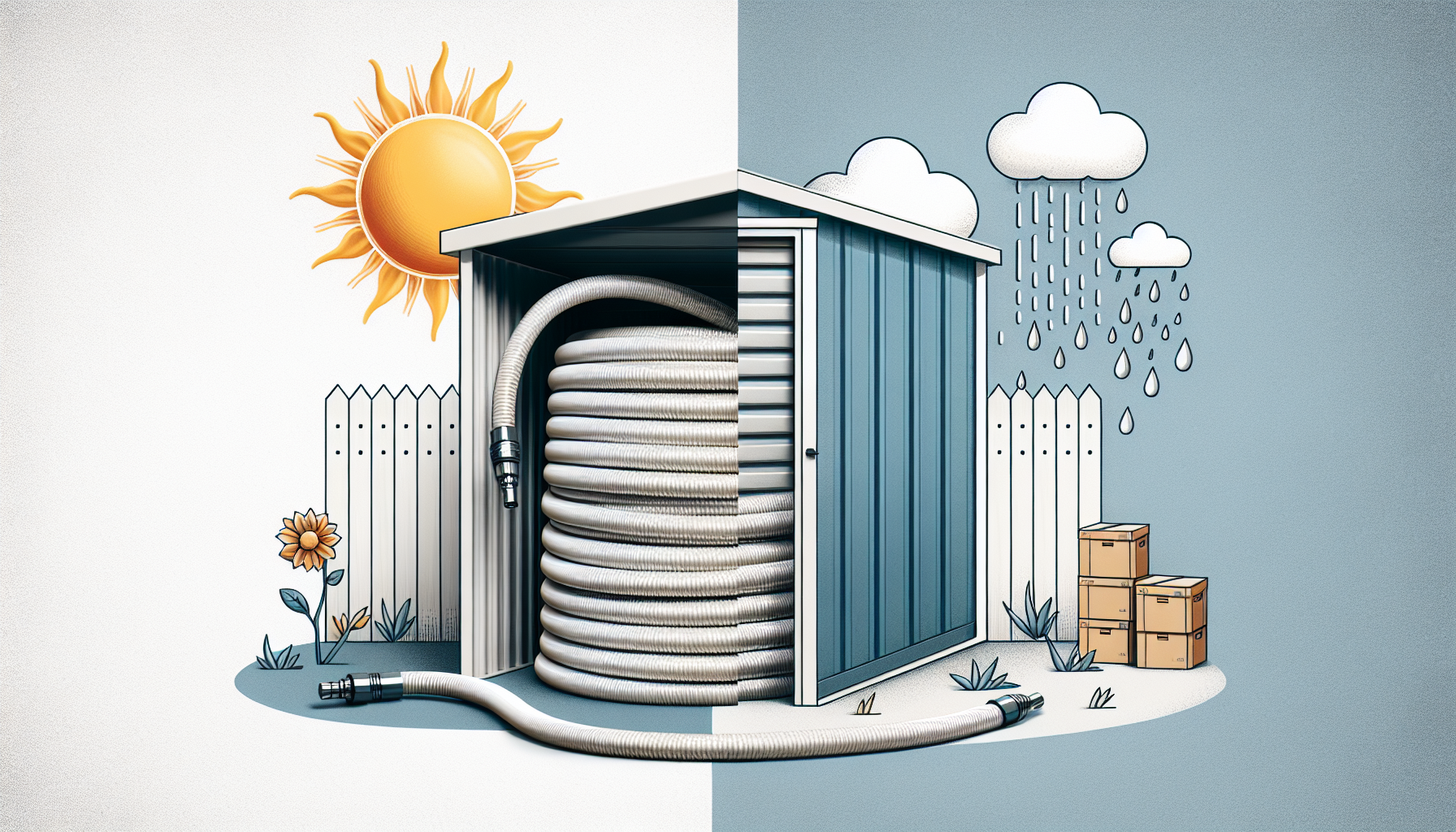Imagine never having to worry about your garden hose getting tangled or damaged again. In this article, we explore the question of whether hoses should be stored indoors or not. We will examine the advantages and disadvantages of keeping your hose inside and provide you with valuable insights to help you make an informed decision. So, let’s dive in and discover the best way to keep your hose safe and secure!

Benefits of Storing Hoses Indoors
Protection from Sun and UV Damage
One of the key benefits of storing hoses indoors is the protection they receive from the sun and UV damage. When hoses are constantly exposed to sunlight, the UV rays can deteriorate the material over time, leading to cracks, leaks, and reduced lifespan. By storing hoses indoors, you shield them from harmful UV rays and prolong their durability.
Prevention of Freezing and Cracking
In colder climates, storing hoses indoors is essential to prevent freezing and cracking. When water inside the hose freezes, it expands, putting pressure on the hose walls. This can result in cracks and leaks, rendering the hose useless or requiring costly repairs. Storing hoses indoors helps maintain a consistent temperature, preventing freezing and the subsequent damage that can occur.
Reduced Risk of Tripping and Damage
Storing hoses indoors reduces the risk of tripping and potential damage. When hoses are left lying around outdoors, they can become a hazard, especially in high-traffic areas. Additionally, hoses left outdoors are more susceptible to being accidentally run over by vehicles or damaged by other outdoor equipment. By storing hoses indoors, you create a safer environment and minimize the chances of accidents or unnecessary damage.
Increased Lifespan of the Hose
Storing hoses indoors can significantly increase their lifespan. By protecting hoses from harsh weather conditions, such as extreme heat, cold, and prolonged exposure to moisture, you can ensure that they remain in good condition for longer. This not only saves you money in the long run by avoiding frequent hose replacements but also ensures that you have a reliable hose for all your watering and cleaning needs.
Factors to Consider Before Storing Hoses Indoors
Availability of Storage Space
Before deciding to store your hoses indoors, it’s important to assess the availability of storage space. Consider how many hoses you have and whether you have adequate space to accommodate them without causing clutter or inconvenience. Ensure that the storage area is large enough to hold the hoses comfortably and allows for easy access when needed.
Proximity to Outdoor Use
Another factor to consider is the proximity of the indoor hose storage area to outdoor use. Ideally, you’ll want the storage space to be located near the areas where you typically use the hoses. This ensures that you can easily retrieve and return the hoses without excessive effort. If the indoor storage area is too far from the outdoor areas where you use the hoses, it may become less convenient and time-consuming to transport them back and forth.
Draining and Drying Requirements
Proper draining and drying of hoses are important considerations when storing them indoors. Before storing your hoses, ensure that you remove any excess water by draining them thoroughly. This helps prevent the growth of mold and mildew within the hose. Additionally, make sure the storage area allows for proper air circulation to promote drying and minimize the risk of water damage.
Potential for Mold and Mildew Growth
Storing hoses indoors can increase the potential for mold and mildew growth if not properly managed. To prevent this, ensure that the storage area is clean, dry, and well-ventilated. Avoid storing hoses in damp or poorly ventilated spaces, as this can create a favorable environment for mold and mildew to thrive. Regularly inspect the hoses for any signs of mold or mildew growth and address the issue promptly if detected.
Alternative Options for Outdoor Hose Storage
Wall-Mounted Hose Reels
If storing hoses indoors is not a viable option for you, consider investing in wall-mounted hose reels. These allow you to store the hoses neatly and securely against the wall, minimizing tripping hazards and maximizing space efficiency. Wall-mounted hose reels often have a retractable feature, making it easy to extend and retract the hose as needed.
Hose Stands and Hangers
Hose stands and hangers are another alternative for outdoor hose storage. These provide a dedicated space for storing your hoses while keeping them off the ground. Hose stands typically feature a sturdy base and a post or hanger to hang the hose from. They are easy to set up and offer a convenient way to organize hoses without taking up excessive space.
Hose Pots and Containers
Hose pots and containers offer a decorative and functional solution for storing hoses outdoors. These pots come in various styles and materials, such as clay, resin, or metal. Simply coil the hose neatly inside the pot, and it will be protected from the elements while adding a touch of aesthetic appeal to your outdoor space.
Underground Hose Storage Systems
For a more discreet and integrated solution, underground hose storage systems can be installed. These systems involve burying a designated compartment in the ground, allowing you to store the hose beneath the surface. When not in use, the hose can be easily retrieved and retracted. While this option requires more planning and installation, it offers a seamless and unobtrusive way to store your hoses.
Potential Drawbacks of Storing Hoses Indoors
Limited Space and Accessibility
One potential drawback of storing hoses indoors is the limitation of space and accessibility. If you have limited storage space indoors, it may be challenging to find a suitable area to keep your hoses without causing clutter or inconvenience. Additionally, if the hoses need to be frequently retrieved and stored, it can become a tiring and time-consuming task if the storage area is not easily accessible.
Potential for Damage to Indoor Surfaces
Storing hoses indoors can also pose a risk of damaging indoor surfaces. If the hoses are not properly drained or leak, water may seep onto the floor or walls, potentially causing water damage or mold growth. It is crucial to ensure that hoses are thoroughly drained and in good condition before storing them indoors to minimize the risk of any water-related damage.
Potential for Water and Moisture Damage
While storing hoses indoors can protect them from external elements, there is still a potential risk of water and moisture damage. If the storage area is not adequately ventilated or has a high level of humidity, it can create an environment conducive to the growth of mold and mildew. Regular inspection and maintenance of the storage area are necessary to identify and address any potential water or moisture damage issues.
Inconvenience of Frequent Removal and Storage
If you frequently use your hoses throughout the day or require them for various tasks, storing them indoors may be inconvenient. The need to repeatedly retrieve and store the hoses can become time-consuming and disruptive. In such cases, alternative outdoor hose storage options, such as hose reels or stands, may be more suitable to provide easy access while minimizing the inconvenience of constant removal and storage.

Tips for Storing Hoses Indoors
Clean and Dry the Hose Before Storage
Before storing your hoses indoors, it’s important to clean and dry them thoroughly. Use a hose nozzle or attachment to flush out any dirt or debris from the inside. Once cleaned, hang the hose up or lay it out flat to dry completely. Storing a clean and dry hose reduces the risk of mold growth and ensures its longevity.
Coil the Hose Properly
When storing your hose indoors, it’s crucial to coil it properly to prevent kinks and tangles. Start by holding the hose by one end and then coil it in a large, loose circle, moving in a clockwise direction. Avoid tight coils as they can cause stress on the hose and reduce its lifespan. A properly coiled hose is not only easier to store but also avoids unnecessary damage.
Use Hose Reels or Hangers
Investing in hose reels or hangers can greatly improve hose storage indoors. Hose reels allow for easy winding and unwinding, while hangers keep the hose off the ground and prevent tangling. Opt for a quality hose reel or hanger that can securely hold your hose and make it readily accessible whenever needed.
Store in a Dry and Well-Ventilated Area
To prevent mold and mildew growth, it’s important to store your hoses in a dry and well-ventilated area. Avoid storing hoses in damp basements or unventilated garages, as these environments can promote moisture buildup. Choose a storage area with optimal air circulation and ensure that the space is free from any excess humidity or moisture.
Alternatives to Storing Hoses Indoors
Covering and Protecting Outdoor Hose
If storing hoses indoors is not feasible or preferred, consider covering and protecting your outdoor hose. Use a durable hose cover to shield the hose from direct sunlight and UV damage when it is not in use. Additionally, invest in hose caps or plugs to prevent any debris or insects from entering the hose when it is disconnected from the water source.
Using Insulated Hose Covers
In colder climates, using insulated hose covers can help prevent freezing and cracking. Insulated covers provide an additional layer of protection, keeping the water inside the hose from freezing even in extremely low temperatures. These covers can be easily wrapped around the hose and offer insulation that retains heat.
Draining Hoses and Disconnecting from Faucets
Properly draining the hoses and disconnecting them from outdoor faucets is crucial to prevent freezing and damage. After each use, ensure that you drain the water from the hoses completely. Disconnect the hoses from the outdoor faucets and allow any remaining water to drain out. Hang the hoses up or coil them properly until they have dried completely before covering or storing them.
Proper Hose Maintenance and Inspection
Regular maintenance and inspection of your outdoor hoses are vital for their longevity and performance. Check for any signs of wear and tear, such as cracks, leaks, or damaged connectors. Address any issues promptly to avoid further damage. Additionally, keep the hoses clean and free from debris, as accumulated dirt can clog the nozzle or affect the water flow.
Considerations for Different Climates
Cold Climates
In cold climates, it is especially important to store hoses indoors to prevent freezing and cracking. Ensure that the storage area is heated or insulated to maintain a consistent temperature. Additionally, consider using insulated hose covers and draining the hoses thoroughly after each use to eliminate any remaining water that can freeze.
Hot and Dry Climates
In hot and dry climates, storing hoses indoors can protect them from the damaging effects of extreme heat and prolonged sun exposure. Ensure that the storage area is well-ventilated and shielded from direct sunlight to prevent UV damage. Additionally, check the hoses regularly for any signs of heat-related deterioration and address them promptly.
Humid and Tropical Climates
In humid and tropical climates, the risk of mold and mildew growth is higher. When storing hoses indoors, prioritize a well-ventilated area to prevent excess humidity and promote airflow. Regularly inspect the hoses for any signs of mold or mildew and take immediate action if detected. Consider using hose covers in these climates to provide an extra layer of protection against moisture.
Seasonal Changes and Transitioning
During seasonal changes or when transitioning between different climates, it is important to adapt your hose storage practices accordingly. Pay attention to the specific requirements of your hoses during transitional periods. For example, in colder seasons, ensure thorough draining and proper insulation to prevent freezing. During hot and dry seasons, focus on protection from intense heat and UV damage.
Addressing Common Myths and Misconceptions
Myth: Storing Hoses Indoors Always Leads to Mold
This is not necessarily true. While storing hoses indoors can increase the potential for mold and mildew growth if not properly managed, a clean, dry, and well-ventilated storage area can mitigate this risk. Regular inspection and maintenance can prevent mold and ensure the longevity of your hoses.
Myth: Hoses Must Always Be Stored Outdoors
Storing hoses outdoors is a common practice, but it is not always the best option. Factors such as climate, convenience, and the risk of damage should be considered when deciding where to store hoses. Storing hoses indoors can offer significant benefits, especially in terms of protection and increased lifespan.
Myth: Storing Hoses Indoors Causes Damage to Materials
When hoses are stored indoors correctly, there should be minimal risk of damage to the materials. Proper draining, adequate drying, and avoiding contact with sharp or abrasive surfaces can help ensure that the hoses remain in good condition. However, it is essential to regularly inspect the hoses and address any issues promptly to avoid potential damage.
Myth: Outdoor Hose Storage is Always Convenient
While outdoor hose storage can be convenient in terms of accessibility, it is not always the most practical option for everyone. Factors such as limited space, risk of damage, and frequent removal and storage can make outdoor hose storage inconvenient. Storing hoses indoors may provide a more suitable solution for those facing such challenges.
Practical Recommendations for Individual Situations
Gardening Enthusiasts
Gardening enthusiasts who frequently use hoses for watering plants can benefit from storing hoses indoors. By doing so, they protect the hoses from sun damage, freezing, and potential tripping hazards. Utilizing hose reels or hangers can provide easy access and organization while maintaining a neat and clutter-free gardening space.
Professional Landscapers
Professional landscapers often rely heavily on hoses and require durability and accessibility. Storing hoses indoors can ensure the longevity and reliability of their equipment while minimizing the risk of damage and inconvenience. Identifying the most suitable storage area and using dedicated hose storage solutions can streamline their workflow and save time.
Homeowners with Limited Storage Space
For homeowners with limited storage space, storing hoses indoors can be a challenge. However, exploring alternative outdoor hose storage options such as wall-mounted hose reels or hose stands can help maximize space efficiency. It is essential to prioritize the protection and maintenance of hoses even when storage space is limited.
Homeowners with Ample Indoor Storage
Homeowners with ample indoor storage space have the advantage of being able to store hoses indoors without major constraints. They can designate a specific area or room for hose storage, ensuring that the hoses remain protected and accessible when needed. Proper organization and maintenance are key to making the most of the available storage space.
Conclusion
In conclusion, the decision of whether to store hoses indoors depends on various factors such as climate, convenience, and available storage space. Storing hoses indoors offers numerous benefits, including protection from sun and UV damage, prevention of freezing and cracking, reduced tripping hazards, and increased lifespan. However, it is also essential to consider factors such as space availability and proximity to outdoor use. Additionally, alternative outdoor hose storage options, such as hose reels, stands, pots, or underground storage systems, can be considered. It is important to address potential drawbacks, such as limited space and accessibility, potential damage to indoor surfaces, and the risk of water and moisture damage. By following proper storage practices, such as cleaning and drying hoses before storage, coiling them properly, and using hose reels or hangers, you can ensure the longevity and performance of your hoses. Alternatives to storing hoses indoors, such as covering and protecting outdoor hoses or practicing proper drainage and maintenance, can also be effective solutions. Considerations for different climates, addressing common myths and misconceptions, and providing practical recommendations for specific situations further enhance the understanding and applicability of hose storage practices. Ultimately, the decision to store hoses indoors or outdoors should be based on personal circumstances and the desire to prioritize the protection and longevity of your hoses.
